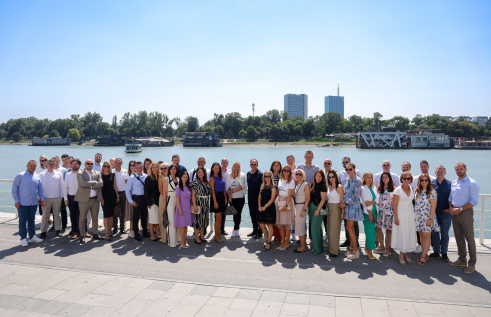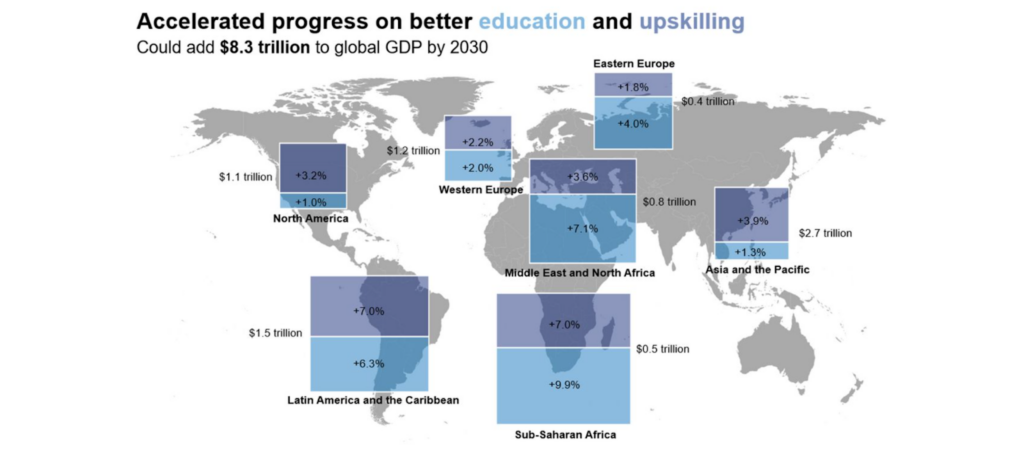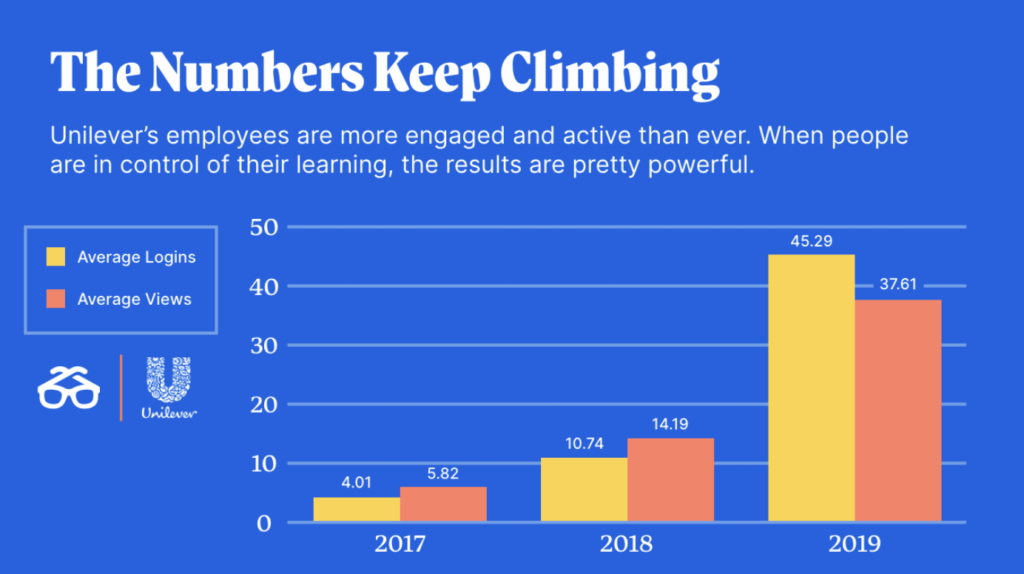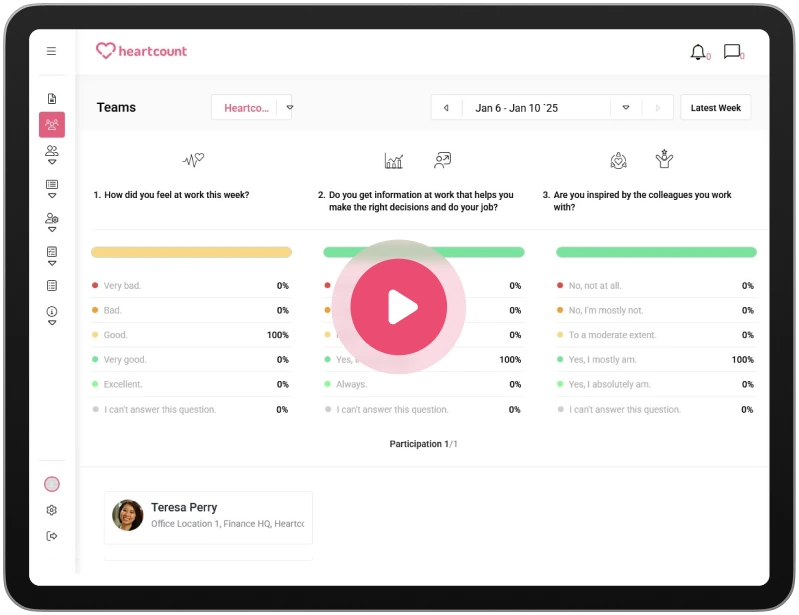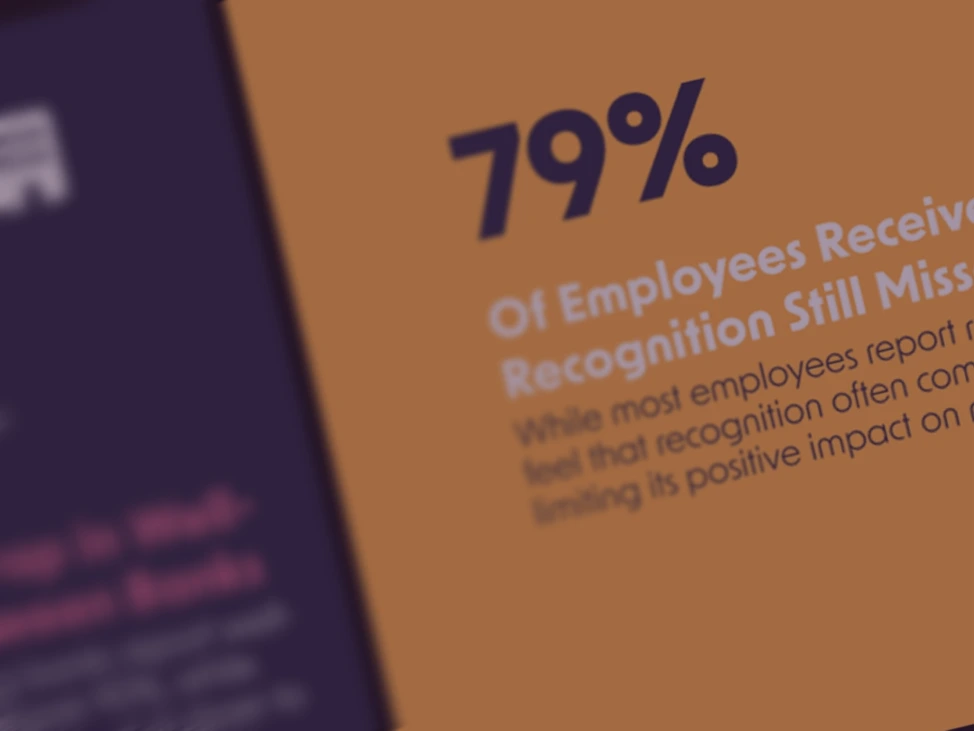25 employee growth and development ideas for 2025

“The only thing worse than training your employees and having them leave is not training them and having them stay.”
This quote from Henry Ford reminds us of the critical role employee development plays in maintaining a competitive, innovative workforce. As companies face rapid technological advancements, remote work challenges, and diverse learning needs, investing in professional growth isn’t just a nice-to-have; it’s a critical business strategy. Organizations that want to remain competitive, innovative, and successful in the market must adopt employee-centric practices.
This shift addresses immediate business needs and ensures long-term sustainability by fostering continuous growth and adaptability among employees.
Turning towards an employee-centric approach isn’t merely a response to change but a proactive strategy to thrive in it.
“The only thing worse than training your employees and having them leave is not training them and having them stay.”
This quote from Henry Ford reminds us of the critical role employee development plays in maintaining a competitive, innovative workforce. As companies face rapid technological advancements, remote work challenges, and diverse learning needs, investing in professional growth isn’t just a nice-to-have; it’s a critical business strategy. Organizations that want to remain competitive, innovative, and successful in the market must adopt employee-centric practices.
This shift addresses immediate business needs and ensures long-term sustainability by fostering continuous growth and adaptability among employees.
Turning towards an employee-centric approach isn’t merely a response to change but a proactive strategy to thrive in it.
The growing importance of employee development in 2025
In today’s market, an effective employee development program is no longer a luxury—it’s a necessity for staying ahead of the competition.
This is not news. Two decades ago, Lawrence A. Bossidy shared his transformative journey with AlliedSignals for Harvard Business Review. He stepped up as CEO in difficult times for AlliedSignals and reconstructed it in less than five years. His secret? He bet on people and employee development through honest conversation, high targets, and applicable training plans.
When asked how he made it, he simply responded:
I am convinced that nothing we do is more important than hiring and developing people. At the end of the day, you bet on people, not on strategies. Strategies are intellectually simple; their execution is not. Your strategies will not make you a better company. Of course, you want to have a good idea of where you’re going, but that’s not enough. The question is, Can you execute? That’s what differentiates one company from another.
Bossidy’s point of view: “If you don’t have the best people, you hurt everyone.”
Employee development enhances skills and improves employee retention and satisfaction, two factors that directly affect an organization’s performance.
The World Economic Forum’s findings show that 50% of employees will need reskilling due to the rapid pace of technological change, which makes strategic investments in learning and development essential for maintaining a capable, future-ready workforce.
This statistic highlights the urgency for businesses to adopt employee training and employee development programs that keep pace with industry advancements. The shift to remote and hybrid work environments also underscores the need for employees to develop new skills for virtual collaboration and productivity.
Moreover, diverse learning preferences and limited budgets present additional challenges. Employees today seek development opportunities that fit their individual learning styles, whether through microlearning, mentorship, or hands-on experiences. At the same time, organizations must navigate budget constraints while providing meaningful growth opportunities. Therefore, businesses must be strategic and innovative in their approach to employee development to remain competitive and foster a skilled, adaptable workforce.
25 employee growth and development ideas for 2025
The latest Workplace Learning Report reveals that organizations prioritizing employee growth see significantly lower employee turnover rates and higher satisfaction among their staff. By investing in development, companies not only equip their employees with the skills needed to adapt to new challenges but also build a more engaged and committed workforce.
Here are some ideas for supporting your employees’ growth and development.
1. Personalized learning paths
Personalized learning paths offer tailored educational journeys that align with each employee’s career goals and the organization’s objectives. This approach ensures that training is directly relevant to the employee’s role, making it more meaningful and impactful.
In fact, Deloitte highlights the value of a strong learning culture, noting that organizations with this focus have 30-50% higher retention rates. Their Deloitte University serves as an example, fostering leadership skills and human capabilities like social intelligence and resilience. This allows employees to adapt to technological changes while enhancing collaboration and development.
If you’re considering implementing personalized learning paths in your organization, start by assessing each employee’s career goals and current skill levels. From there, you can design a custom learning plan with relevant courses, workshops, and mentorship opportunities. Use a Learning Management System (LMS) to deliver these resources and track progress effectively.
2. Mentorship programs
Mentorship programs involve pairing less experienced employees with seasoned professionals to facilitate knowledge transfer and skill development. These programs are designed to support career growth and leadership development through structured guidance.
To implement a mentorship program, you’ll first need to define the objectives of the program. Then, you can match mentors and mentees based on career aspirations and expertise. In the end, training for mentors and regular check-ins should be provided to monitor progress.
A great example of a good mentorship program implementation is Google’s Career Guru program. This program pairs employees with experienced mentors to help them navigate career decisions, develop new skills, and find growth opportunities. It provides a structured approach to career mentorship across various roles. Over 900 Google engineers participated in the program in the first two years, giving it an average employee satisfaction rate of 4.8 out of 5. The latest data shows that 76.3% of satisfied employees have no intention of looking for alternative opportunities. This program is most frequently cited as one of the critical reasons Google is one of the best employers in the world.
3. Cross-departmental projects
Cross-departmental projects involve employees working on initiatives that span multiple departments, broadening their understanding of the organization and enhancing collaboration skills. To make a project like this work, you’ll need to identify key projects that benefit from diverse departmental input. Furthermore, you should select employees from various departments to participate. Then, facilitate regular meetings and collaborative sessions to ensure effective communication.
For example, Google encourages cross-functional collaboration through its 20% Time initiative, which allows employees to spend 20% of their time working on projects outside their primary roles. They often collaborate with teams from different departments to drive innovation and creative problem-solving.
4. Employee-led workshops and training
Employee-led workshops leverage the expertise of employees to provide training and knowledge sharing within the organization. This approach fosters a culture of continuous learning and recognizes employee contributions.
To have a successful employee-led workshop or training, you’ll first need to identify employees with expertise in specific areas. After that, you’ll need to provide resources and support for developing workshop content and then schedule and promote workshops to encourage participation.
For instance, Zappos exemplifies this approach through its internal learning platform, “Zappos Insights.” Here, employees lead workshops and training sessions on topics like customer service, corporate culture, and team building, sharing their valuable insights and best practices across the organization.
5. Continuous feedback and development check-ins
Continuous feedback means having regular, structured conversations between employees and managers to make sure development goals align with performance outcomes. This keeps development efforts relevant and effective by maintaining an ongoing dialogue about progress and challenges.
To make this work, start by scheduling regular one-on-one meetings focused on feedback and goal setting. Use these meetings to talk about progress, tackle any challenges, and adjust development plans as needed. It’s also important to document feedback and track improvements over time.
Netflix is a great example of how effective continuous feedback can be. Their focus on regular, constructive feedback has led to a 75% increase in project success rates, showing just how powerful a culture of open communication and ongoing development can be.
Use tools like HeartCount to establish measurable feedback and stay updated on your employees’ growth and development needs. For example, HeartCount’s custom surveys and automated pulse checks can provide valuable insights into your employees’ aspirations and how they align with business goals.

6. Microlearning opportunities
Microlearning delivers educational content in short, focused segments, catering to employees’ busy schedules and varied learning preferences. This method allows for flexible, on-demand learning.
To implement this idea, you first need to develop brief, targeted learning modules on specific topics. You then need to integrate these modules into daily workflows. Finally, analytics can be used to monitor employee engagement and effectiveness.
Walmart, for example, uses microlearning through its Walmart Academy app, which delivers short, targeted training sessions to employees on the retail floor. This method ensures that employees can quickly gain knowledge while working without needing extensive time away from their duties.
7. External learning and certification programs
Supporting external learning programs and certifications helps employees gain specialized skills and credentials. This investment in external education benefits both the employee and the organization.
If you want to implement a program like this in your organization, you’ll need to identify relevant certification programs and external learning opportunities. Then, you should provide financial support or reimbursement for course fees. In the end, they should recognize and integrate new skills into the organization.
For example, Intel Corporation is deeply committed to growth and people development, recognizing that learning is a lifelong journey. Through their Tuition Assistance Program, Intel offers financial support of up to $10,000 for employees to pursue higher education and external certifications in areas like technology, leadership, and business, ensuring that employees can advance their skills with little to no tuition cost.
8. Job rotation and stretch assignments
Job rotation and stretch assignments expose employees to different roles or projects, which helps them develop a broader skill set and prepares them for future leadership positions. By giving employees the opportunity to take on new challenges, these strategies not only enhance their capabilities but also keep them engaged and motivated.
To implement this idea, start by identifying key roles and projects that would be suitable for rotation or stretch assignments. Align these assignments with employees’ career goals and development needs. Finally, monitor their progress and provide support throughout the assignments to ensure they gain the most from these opportunities.
Unilever set a good example for implementing this idea. Their Future Leaders Programme includes job rotations, where employees experience different functions and departments, broadening their skills and understanding of the business. This helps employees prepare for leadership positions by giving them a well-rounded view of the organization.
9. Leadership development programs
Leadership development programs aim to build essential skills such as strategic thinking and decision-making, preparing employees for advanced roles within the organization. These programs are designed to cultivate future leaders by equipping them with the tools and knowledge needed to excel in higher-level positions.
To create an effective leadership development program, start by designing a curriculum that includes workshops, coaching sessions, and strategic exercises. Select participants based on their potential for future leadership roles and continually evaluate the program’s effectiveness. Providing ongoing support and feedback ensures that employees can apply what they’ve learned and continue to grow as leaders.
PepsiCo’s Global Leadership Development Program is the perfect example of a program of this type. It combines classroom learning, on-the-job training, and coaching to build leadership skills in high-potential employees preparing for leadership roles. By implementing a global session through the Leadership and Organizational Management (LOM) initiative, PepsiCo has streamlined the process, saving approximately $950,000 in costs that would have been incurred through regional duplication and an additional $853,000 in program delivery fees, demonstrating the program’s efficiency and cost-effectiveness.
10. Collaborative learning platforms
Collaborative learning platforms allow employees to share knowledge and engage in peer-to-peer learning, which helps foster a culture of innovation and collective growth. These platforms create an environment where team members can learn from each other, exchange ideas, and build on shared experiences.
To implement such a platform in your organization, start by setting up an internal system for discussions, resource sharing, and collaboration. Encourage employees to actively participate and contribute their insights. Regularly monitor engagement levels and gather feedback to continuously improve the platform and ensure it meets the evolving needs of your team.
For example, Unilever leverages the collaborative learning platform Degreed to empower employees by facilitating skill development and knowledge sharing across the organization. This approach, centered on peer-to-peer learning, allows employees to create and share content, fostering a culture of continuous improvement. Engagement and activity within the platform have grown significantly, driving higher employee job satisfaction.
11. Innovation challenges and hackathons
Innovation challenges and hackathons are great ways to inspire employees to tackle problems creatively and generate new ideas in a structured, competitive setting. These events encourage out-of-the-box thinking and collaboration, driving innovation within your organization.
To set up an effective innovation challenge or hackathon, organize events centered around specific challenges or projects. Invite employees from various departments to take part, fostering diverse perspectives and teamwork. Provide the necessary resources and support to help participants develop and present their ideas, ensuring they have everything they need to succeed.
A great example is Mastercard that holds hackathons and Sandbox Challenges to encourage employees to work on developing innovative solutions for payment technology. These challenges focus on fostering creativity and bringing new ideas to market. Last year, Mastercard grew by 12.6% and earned $25.7 billion in revenue, which Michael Fraccaro, Mastercard’s Chief People Officer, partially attributes to their culture of innovation.
12. Wellness and resilience programs
Wellness and resilience programs are designed to support employees’ mental and physical well-being, helping them manage stress and maintain productivity. By focusing on holistic health, these programs contribute to a more balanced and resilient workforce.
To create effective wellness and resilience programs, consider incorporating stress management, mindfulness, and fitness activities. Offer resources like on-site wellness classes and access to mental health support. Promote participation in these programs and regularly assess their impact on employee well-being to ensure they are meeting the needs of your team.
Barclays started an amazing campaign in 2013 called “This is Me.” The campaign aimed to challenge the stigma around disability and mental health by encouraging colleagues to share their personal stories. The campaign’s impact has expanded significantly, reaching over 900,000 employees across 500 organizations since its collaboration with the City of London’s Lord Mayor’s Appeal in 2016. To celebrate its 10-year anniversary in 2023, Barclays produced a series of micro-documentaries featuring 18 colleagues, highlighting diverse stories and achieving a 100% increase in employees openly discussing their disabilities or mental health conditions.
With HeartCount’s automated pulse checks, you can monitor employee well-being on a weekly basis and provide ongoing support to your team.

13. On-demand learning resources
On-demand learning resources offer employees flexible access to training materials, catering to various learning preferences and schedules. This flexibility allows employees to engage with educational content at their own pace, making it easier to fit learning into their busy lives.
To implement this approach, begin by developing a comprehensive library of online courses, webinars, and instructional videos. Ensure that employees can access these resources whenever they need them. Monitor usage patterns and gather feedback to continually refine and enhance the offerings, ensuring they remain relevant and effective for your team.
Once again, Google sets a great example. They provide employees with access to their “g2g” (Googler-to-Googler) platform, which features a wide variety of on-demand training materials, including mentoring sessions and recorded courses. This flexible learning system helps employees grow in their roles.
14. Performance-based development plans
Performance-based development plans align employee growth with specific performance outcomes and business objectives, driving targeted improvements. By connecting development efforts directly to measurable results, these plans help ensure that employee growth supports overall business goals.
To create an effective employee performance-based development plan, start by setting clear, measurable goals that are linked to key performance metrics. Design development activities that are tailored to achieving these goals. Regularly review progress and use performance data to adjust the plans as needed, ensuring they remain aligned with both individual and organizational objectives.
For example, Adobe’s “Check-in” program emphasizes ongoing feedback and recognition, replacing traditional annual reviews with regular, meaningful conversations between employees and managers.
15. Recognition and rewards for learning achievements
Recognizing and rewarding learning achievements motivates employees to actively engage in work on their professional development plans. When employees see that their learning is valued, they are more likely to stay committed to continuous improvement.
To implement this approach, start by establishing a recognition program that includes certificates, bonuses, or public acknowledgement for development milestones. Celebrate achievements in training and learning activities, making sure to highlight these successes across the organization. This not only boosts employee morale but also communicates the importance of continuous learning to everyone on the team.
Cisco’s Connected Recognition program is funded at 1% of payroll, showing the company’s commitment to recognizing and rewarding employees. This investment reflects Cisco’s dedication to creating a culture of appreciation.
With the HeartCount Peer recognition feature, employees can send and receive kudos that are visible to everyone in the company. This provides HR managers and team leaders with valuable data and insights into individual employee growth efforts and development.
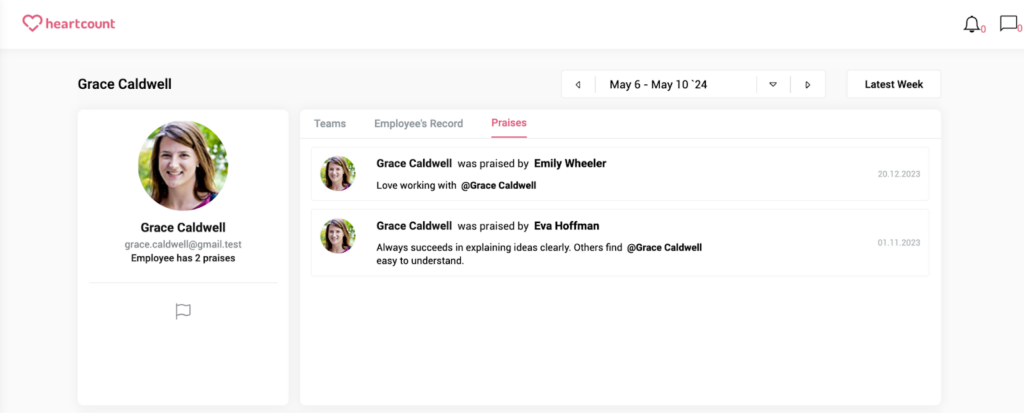
16. Virtual reality (VR) and augmented reality (AR) training
VR and AR training technologies offer immersive learning experiences, allowing employees to practice real-world scenarios in a controlled, hands-on environment. These tools provide a unique professional development opportunity for employees to develop skills through interactive simulations, making training more engaging and effective.
To support your employees’ growth with this approach, start by finding or, even better, developing VR or AR simulations tailored to your industry or specific training needs. Integrate these simulations into your existing training programs, ensuring they complement your learning objectives. Continuously evaluate their effectiveness and gather employee feedback to refine and improve the simulations over time.
Boeing is one of the few companies that ace this. Boeing uses AR to train engineers and assembly workers on complex manufacturing tasks, like deploying and wiring electronic and electrical components. AR overlays visual instructions on real-world objects, helping employees learn how to assemble aircraft parts more efficiently. By implementing VR, Boeing cut the training time by 75% and increased accuracy by 33% using AR.
17. Gamification of learning
Gamification brings game-like elements into learning activities, boosting engagement and motivation by making the experience interactive and enjoyable. By incorporating rewards, challenges, and competition, it transforms learning into a more dynamic and fun process.
To introduce gamification to your team, consider adding elements like points, badges, and leaderboards to your training programs. Your HR team can also design gamified activities that align with key learning objectives, keeping the focus on meaningful skill development. Be sure to monitor participation and adjust the gamification strategies as needed to ensure they remain effective and motivating for employees.
For example, Deloitte uses gamification in its leadership development programs, incorporating badges, leaderboards, and rewards to encourage participation in training courses. Their “Leadership Academy” is designed to motivate employees to complete learning modules and engage in continuous development. Since implementing this idea, they have seen a 37% increase in the number of users returning to the site every week.
18. Peer coaching and skill-sharing circles
Peer coaching and skill-sharing circles allow employees to mentor one another and exchange expertise in a structured, collaborative format. This approach fosters a culture of teamwork and continuous learning by encouraging employees to share their knowledge and skills.
To start a skill-sharing circle in your organization, begin by identifying key areas of focus and setting clear guidelines for effective mentoring. Your HR team can facilitate these sessions, ensuring they run smoothly and provide value. Gathering feedback from participants will help refine and improve the process, making it even more effective over time.
AirBnB, for example, has started its internal Data University with the goal of empowering its employees to make data-driven decisions. Airbnb’s internal training program features a faculty of 55 volunteers from the Data Science and Engineering teams, who teach over 20 unique courses globally each year. The curriculum is divided into three levels, starting with foundational courses on data-informed decision-making (100-level) and advancing to more complex topics like Bighead, Airbnb’s machine learning platform, and Airflow, its data pipeline automation tool (300-level). Since launching in 2016, the program has delivered more than 400 courses, and over 6,000 participants have benefitted from these sessions.
The Data U program benefited Airbnb’s data science teams by reducing ad hoc requests by 50%, allowing data scientists to focus on higher-impact projects. For the business, over 80% of team members began regularly using data tools, with most reporting that they now rely on data for their decision-making processes.
19. External networking opportunities
Supporting external networking opportunities helps your employees build industry connections and gain valuable insights from outside the organization, which can greatly enhance their professional growth. By interacting with peers and experts, employees bring fresh ideas and perspectives back to the team.
You can encourage this by helping employees attend industry conferences, workshops, and networking events. Offering support for travel expenses or registration fees can make it easier for them to participate. Afterwards, facilitate knowledge-sharing sessions to ensure the whole organization benefits from what they’ve learned.
A great example, again, is Google, which offers Conference Scholarships to support underrepresented groups in technology and business by helping them attend leading industry conferences. The scholarships cover conference registration, travel, accommodation, and a stipend of $100 for miscellaneous expenses, allowing employee career growth.
20. Customized development plans based on employee feedback
Customized development plans are tailored to each employee’s unique needs, taking into account their personal goals, interests, and feedback to ensure that growth opportunities are relevant and effective. This approach fosters more meaningful development by aligning training with what employees truly want and need to improve.
To implement something like this in your organization, start by collecting employee feedback about their development needs and preferences. Your team could then create personalized development plans based on this feedback. Just make sure to regularly review and adjust plans based on ongoing feedback and progress.
IBM is a great inspiration for this practice. The company offers a personalized training experience for employees through its AI-powered platform, “Your Learning.” This system provides tailored learning suggestions based on each employee’s role, career objectives, and previous training. It also highlights emerging skills that are in high demand, helping employees stay current with industry trends and prepare for future opportunities.
21. Interactive workshops and simulation exercises
Interactive workshops and simulation exercises (not to be confused with VR and AR) provide employees with hands-on learning experiences through role-playing and real-world scenarios. This approach enhances the understanding and application of new skills in a practical context.
If you’re thinking about introducing workshops and simulation exercises into your organization, you’ll need to design ones based on real-life challenges relevant to your employees’ roles. You should then engage facilitators or experts to lead these sessions and incorporate feedback and reflections to maximize learning outcomes.
Airbus, for example, uses the HATS Helionix Trainer to help pilots and technicians smoothly move from theory to practice with Helionix-equipped aircraft. This tool features a troubleshooting simulator and an interactive procedure trainer, providing hands-on experience with real-world scenarios to boost both technical skills and operational understanding.
22. Collaborative problem-solving sessions
Collaborative problem-solving sessions bring together employees to address specific challenges or projects. This method encourages teamwork and leverages diverse perspectives to find innovative solutions.
You can start by identifying key problems or projects that require collaborative input. Then, organize brainstorming and solution-development sessions with cross-functional teams. And, of course, make sure to implement and test proposed solutions and review outcomes for continuous improvement.
Procter & Gamble’s “Connect+Develop” program is a great example of how collaborative problem-solving can drive innovation. When they realized internal R&D alone wasn’t enough to meet their growth goals, they started collaborating with external experts like suppliers, scientists, and even competitors. By bringing together diverse perspectives, they were able to refine ideas and create new products like Olay Regenerist and the Mr. Clean Magic Eraser. This approach led to a 60% boost in their R&D productivity, showing how effective teamwork and collaboration can be in solving challenges and improving processes.
23. Employee development roadmaps
Employee development roadmaps outline clear paths for career advancement and skill development. These roadmaps align individual growth with organizational goals, providing a structured approach to career progression.
Start by collaborating with employees to identify their career goals and the skills they need to achieve them. Next, create personalized roadmaps that outline key milestones, training opportunities, and available support resources. Be sure to regularly review and adjust these roadmaps based on their progress and any changes to their goals.
Adobe supports employee career development through its “Learning Fund,” offering up to $1,000 for training, certifications, and career-building milestones. Employees collaborate with their managers to ensure the chosen coursework aligns with both career and business goals. After securing manager approval, employees can apply for reimbursement through Adobe’s benefits portal once the course is completed, fostering personal growth while contributing to the company’s success.
24. Blended learning approaches
Blended learning combines online and in-person training methods to provide a flexible and comprehensive learning experience, accommodating different learning styles and enhancing knowledge retention.
To implement this approach, start by developing a mix of interactive online modules and in-person sessions that cover key topics. The online content should be engaging, while the in-person sessions can focus on hands-on applications and group discussions. Continuously monitor the effectiveness of this blended approach and make adjustments as needed for ongoing improvement.
For example, True Relationships and Reproductive Health organization offers a blended learning course that combines eLearning modules with short face-to-face or webinar sessions. Since introducing this system in 2019, True has seen a 137% increase in registrations.
25. Knowledge-sharing platforms
Knowledge-sharing platforms facilitate the exchange of information and expertise among employees. By providing a space for sharing insights and best practices, these platforms encourage collaboration and continuous learning.
Start by implementing a platform where employees can share articles, resources, and expertise, like an internal wiki or collaboration tool. Encourage team members to actively contribute and participate in discussions. Make sure to regularly update the platform with relevant content and acknowledge those who are actively engaged.
Salesforce uses “Salesforce Chatter” to encourage knowledge sharing within the company. This platform enables employees to post updates, share documents, and engage in discussions, fostering collaboration and continuous learning.
Aligning employee growth and development with business goals
Integrating an employee development idea with organizational objectives requires a strategic approach that considers both employee aspirations and business needs. Start by gathering feedback through employee surveys, meetings, employee experience platforms, and performance reviews to understand their development goals and preferences. This feedback can guide the creation of an employee development plan that aligns with both individual aspirations and organizational priorities. HeartCount is one of the leading employee experience platforms in the market that will help you create a safe space where people are inspired and excited to work.
Balancing employees’ desires with business requirements involves setting clear career development goals that support organizational objectives while addressing employees’ career growth needs. Regularly reviewing and adjusting development plans based on feedback and performance data ensures that they remain relevant and effective. By aligning employee development with business goals, organizations can foster a motivated and skilled workforce that drives overall success.
Conclusion
Adopting innovative and actionable strategies for employee growth and development is essential for attracting top talent. However, not all discussed approaches will be a perfect fit for your organization. It’s important to assess your own goals, workforce, and unique resources and, based on that, build a development program that drives success and positions your organization as a desirable place to work.
Check out how HeartCount can be your ally in the whole process.



